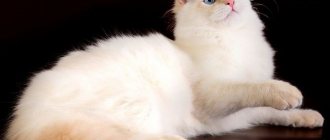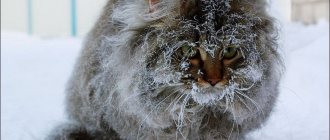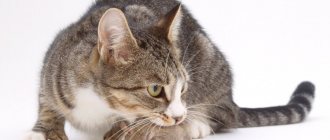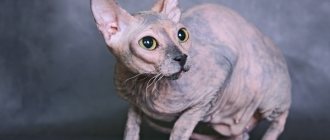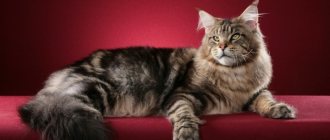The Siberian Neva Masquerade cat is an aristocrat with refined manners, which combines the best qualities such as tenderness, devotion and sociability. Behind the luxurious appearance and apparent sedateness lies a dexterous and fearless hunter, capable of repelling an offender. The Neva cat is demanding of care. Before getting a pet, you should read the recommendations of experienced breeders regarding its maintenance.
Brief history of the breed
This breed originated in the 80s of the last century. It originates from Siberian cats that lived in Russia for centuries. For the first time, breeders of the Kotofey club in Leningrad began breeding Neva Masquerade cats. The work on creating a new breed was led by Olga Mironova, a well-known felinologist at that time.
There is no exact information about the origin of the point color. It is believed that the dark mask of Siberian masquerade cats appeared due to crossing with representatives of the Siamese breed. Some believe that this color was borrowed from color-point Persians.
In 1988, the Neva Masquerade cat took part in an exhibition for the first time, which was held in Leningrad. It was there that the breed got its name, which reflects the place of its origin - this is a city on the Neva. The word “masquerade” perfectly describes the main feature of its appearance - a dark mask on its face. In addition to the official name, the breed has others - carnival cat, nevak.
A little later, Moscow breeders began breeding Siberian Masquerade. However, they preferred to work separately from their Leningrad colleagues. Thanks to this, over time, a wide variety of new colors appeared.
In the early 90s, Russian felinologists began to promote the breed on the international stage. This gave good results - in 1992, the WCF organization registered the Siberian masquerade cat.
Most felinological associations still do not recognize the Neva Masquerade as a separate breed. It is listed in the registers as a color variety of Siberian cats.
Video
* We invite you to watch a video about the Neva Masquerade cat . In fact, in front of you is a playlist in which you can select and watch any of 20 videos about a given cat breed by simply clicking on the button in the upper right corner of the window. In addition, the material contains quite a lot of photos. By looking at them you can find out what the Neva Masquerade cat looks like.
In this article:
|
Rate the material!
[Total votes: 1 Average: 5]
The Neva Masquerade cat is an aristocrat of the cat world. These mannered, graceful animals were bred in Russia and acquired unique character traits. For all their aristocracy, they remain harsh hunters and dangerous predators, capable of standing up for themselves. At the same time, they combine such character traits with the tenderness and attentiveness that goes to the owners of the cat.
Description of the breed
Siberian masquerade cats are very large, by cat standards, animals with long hair and sky blue eyes. The weight of a male can reach 8-10 kg. The weight of more graceful females varies between 5–6 kg.
The Neva cat got its name in honor of its place of origin - the city on the Neva
Exterior characteristics
Representatives of this breed have strong bones and powerful muscles. The WCF standard provides the following characteristics:
- Proportional physique. The body is of medium length. The chest is well developed, the neck is massive.
- The head is quite large in the shape of a trapezoid with smooth outlines. The frontal part is wide, but low. When moving from the forehead to the bridge of the nose, a small depression is barely visible.
- A wide nose of medium length with a neat nose.
- The low-set cheekbones are clearly defined, the cheeks are slightly plump, and the well-developed jaws have a regular structure.
- A strong and wide chin is in line with the nose.
- The ears are medium in size with pointed tips and a fairly wide base, slightly tilted forward. The distance between them should exceed the width of the bottom of the ear. The breed standard does not have strict requirements for the presence of tassels on the tips, but their presence is desirable.
- The eyes are round, large, widely spaced, the outer corners are slightly raised. The iris is colored a rich blue. Cats up to one year old are allowed to have a greenish tint to their eyes.
- The limbs are strong, well muscled, of medium length with rounded powerful paws. Hair grows abundantly between the toes.
- The tail is of moderate length - in most cats it reaches the area of the shoulder blades. The base is wide, the tip is rounded.
Coat type
The Siberian Neva Masquerade cat has thick, semi-long hair. The neck and chest of the animal are decorated with a luxurious collar. There are “pants” on the hind legs. The structure of the wool is dense. Under the guard hairs there is an undercoat, which grows in winter and becomes short with the arrival of warmth.
The cover is smooth to the touch, and shines glossy in the sun. The Nevak's coat lengthens from the shoulder blades to the croup and lies on the sides and base of the tail. It has water-repellent properties and protects well from the cold.
Acceptable colors
The Siberian masquerade cat standard provides for many variations of the Siamese color. The main color of the coat is light, and the coat on the paws, tail and ears is darker.
Table – Colors of the Neva Masquerade cat
| Name of colors | Point color | Nose | Paw pads |
| Seal point (classic) | Dark brown | Dark brown | Dark brown |
| Blue Point | Gray-blue | Gray-blue | Gray-blue |
| Red point | Reddish, orange | From light pink to coral | From light pink to coral |
| Cream point | Beige, cream | Pink, coral | Pink, coral |
| Seal-torty-point. There are dark highlights on the face that resemble flames | Dark brown and red spots on points | Brown | Brown or pink |
| Blue cake point. Flame-shaped highlights on the face | Blue and cream spots on points | Pink, blue-gray | Pink, blue-gray or blue-gray with pink spots |
The tabby point color is very popular, in which the mask can be brown, cream, blue and even tortoiseshell. The letter M is clearly visible on the forehead of such cats, and faint stripes are present on the face, paws and tail. The nose corresponds to the color type and has a dark edging. Tabby point color varieties:
- seal tabby point;
- blue tabby point;
- red tabby point;
- tortie tabby point.
More recently, Siberian masquerade cats with silver, golden and smoky color-point colors have been bred, but they are very rare.
Neva Masquerade with a rare golden color
Breed defects
The disadvantages of the breed include:
- thin bones, underdeveloped muscles;
- angular head shape;
- long neck and limbs;
- ears that are too large or small;
- almond-shaped or small eye size;
- short tail with little hair, and also with a pointed tip;
- lack of shine on the coat;
- poorly or overdeveloped undercoat.
ABOUT THE BREED OF SIBERIAN NEVSKY MASQUERADE CATS
The Siberian cat has been known in Russia since time immemorial. Now it is impossible to determine where exactly the ancestors of these cats came from - from Siberia, the Urals, the Far East or Central Asia... Nevertheless, Siberian cats lived on the European territory of Russia back in the time of Peter I, in other words, the breed is clearly more than three hundred years old. But, meanwhile, no matter how paradoxical it may sound, the Siberian breed is young. In the Soviet Union there was no place for felinological clubs and nurseries - purebred cats, unlike dogs, were not in honor. It was with Siberian cats that Russian felinology began. Only at the end of the last century were breed standards , exhibitions began to be held, and the breed was recognized internationally. Now Siberian and Neva masquerade cats are valued and loved all over the world.
Representatives of the Siberian breed have strong bones, a wide chest, and developed muscles. Their body is squat, strong, with thick paws. The pet's thick, shiny coat with long guard hairs and soft, thick undercoat repels water. Cats of this breed have a rich collar, fluffy pants similar to bloomers, a chic tail, tassels on the ears and paws that protect the paw pads from the cold. In purebred representatives of the Siberian breed, the wool does not mat, does not form tangles, and is easy to care for. The colors of the luxurious fur coat are very diverse. By cat standards, these animals are real giants and tireless and dexterous hunters. Males reach a weight of 4-6 kg, males 6-8 kg, and neuters can weigh over 10 kg. The Siberian cat is the pride of Russian felinology!
The Neva Masquerade cat differs from the Siberian only in its color. The color-point (to put it simply, Siamese) elegant color and bright blue eyes have become a real decoration of the Siberian breed. The beauty of the Neva Masquerade cat will always evoke admiration; the blue of their eyes simply fascinates you!
In its history the Neva masquerade cat , like the Siberian cat , keeps many mysteries. It still remains a mystery where Siberian cats acquired the color gene. It is believed that the breed is based on matings of Siberian and traditional Siamese or Himalayan cats. Only one thing is clear, Neva masquerade cats are a mixture of the power of Siberian cats and the exoticism of the Siamese cat.
The selection of Neva Masquerade cats began in 1989 at the Kotofey club under the leadership of Olga Sergeevna Mironova. The club was located in St. Petersburg, which is why the breed was named after the river on which the city is located. Further work on the breed continued in Moscow. For a very long time, nurseries in St. Petersburg and Moscow preferred to work independently of each other. But even now it is very rare to find animals where the lines of St. Petersburg and Moscow nurseries intersect.
The Siberian breed is recognized by the largest exhibition organizations (WCF, TICA, ICU, CFA, FIFE, ACFA, CFF, UFO, FIAF) and is designated SIB. Only in some felinological systems is the breed of Neva masquerade cats considered independent, has its own standard, different from the standard of Siberian cats of traditional (wild) color, and is designated NEV.
Due to its natural origin, the Siberian cat has excellent health. These outwardly harsh animals are affectionate and sociable, but at the same time self-sufficient and unobtrusive. They are incredibly smart, admire with their grace, beauty and dexterity. They get along well with children and other pets.
Neva masquerade cats are the least allergenic. Allergens in cats are not found in their fur, as was previously mistakenly thought, but in their saliva and skin protein. A recent chemical analysis of saliva showed that Siberian cats lack the Fel D 1 protein, which most often causes allergies. This is not the only factor that causes allergies to cats, but according to researchers at Cornell University (USA), 85% of allergy sufferers react to it.
But remember, allergies have many faces, are difficult to diagnose and treat. Interestingly, cats spread fewer allergens, while cats spread significantly more. And we must take into account the fact that castrated cats and female cats are less allergenic than full-fledged ones.
There are no hypoallergenic cats. And there are no absolute guarantees of anything.
Character and habits
The Siberian masquerade cat seems stern in appearance, but appearances are deceiving. Those who have already had experience keeping these animals speak of them as gentle, devoted and loving pets. They amazingly combine nobility, calmness and the ability to stand up for themselves.
They fearlessly defend their territory and hunt well, despite the fact that they sometimes seem phlegmatic. However, this does not prevent them from showing patience with children. The Siberian masquerade is not capable of offending a child. Feeling tired from the baby’s excessive attention, she will prefer to go to another room.
The pet is equally attached to all family members, willingly accepts affection, but never imposes its company. Behaves cautiously with strangers. When there are a lot of guests at home, the cat usually goes to a quieter place. The animal knows how to sense a person’s mood and often comes to the rescue when the owner is depressed. The pet rarely gives voice, unless very hungry. He can “keep up the conversation” by responding to the owner’s affectionate remarks.
Siberian masquerade cats can get along with dogs, and in rare cases, with other cats, if they do not claim dominance. Pets raised together perceive each other calmly. What the Nevak will not be able to make friends with is small rodents and birds due to its highly developed hunting instinct.
The hunting instinct does not allow nevaks to live in the same apartment with domestic rodents and birds
Character and habits of Neva masquerade cats
Neva masquerade cats have graceful habits. They have a pronounced sense of self-esteem, which does not allow them to behave with these cats like children. With all their appearance and behavior they demonstrate nobility.
Only close people, owners and their children can freely play with this cat. With others, the animal behaves distantly and imposingly, does not show increased interest in new people, and also does not always allow itself to be stroked and, especially, to be picked up.
Neva Masquerade cats are sedate and proud animals with a balanced character. They are attached to family and to home comfort and silence. They like it when they are given attention, but do not ask for it intrusively. They sense the territory well and will not allow new animals into it: there is a high probability that they will respond aggressively to other cats and dogs.
Interesting fact: Owners of Neva Masquerade cats note that the animals love to listen carefully to their owners, are ready to provide emotional support and happily sit on the laps of their loved ones, purring quietly.
Despite their external appearance, Neva masquerade cats are very playful and love to move. Therefore, they get along well with children who are ready to constantly play with their pet. These cats are also characterized by curiosity about everything that concerns their owners: they are nearby when people are doing household chores.
Neva masquerade cats can hardly be called sissies or timid animals. From their ancestors - Siamese and Siberian cats, they received a harsh character and high adaptability to new conditions. You don’t have to worry about these cats if you let them go for walks near a private house. They can fend for themselves and have sufficient intelligence, although supervision of walks is still necessary. Neva masquerade cats themselves do not show aggression unless provoked.
Being good hunters, they can bring mice, birds and even moles into the house. You definitely shouldn't leave them near pet hamsters or parrots.
Health and life expectancy
Siberian masquerade cats live about 13–15 years. Those with a stable immune system rarely get sick. If you provide your pet with adequate nutrition and properly care for it, its life expectancy can increase by another 3-5 years.
The only disease that is more common in Neva masquerade cats is hypertrophic cardiomyopathy. This is a pathology in which the walls of the left ventricle thicken, resulting in heart failure.
Important! The danger lies in the fact that cardiomyopathy does not manifest itself for a long time. The disease gradually progresses and can lead to sudden death.
Neva Masquerade cat - description of the breed
Neva masquerade cats have many differences from their closest relatives: Siberian and Siamese cats, although they inherited a lot from them. This is a fairly large breed. The weight of cats is approximately six kilograms, and the weight of cats is up to nine kilograms. They are proportionate and strong. The body is of medium length, not too stretched. The torso is massive, the neck is short and thick. Volume breasts and strong muscles.
The head is proportional, but massive, wedge-shaped and with smooth, rounded features. The forehead is round, low; wide nose of medium length, without humps. If you look at the cat in profile, there is a noticeable deepening in the transition from the forehead to the nose, but the transition is smooth. The cheekbones are set low, there is a fleshy cheek area, and the jaws are well developed. The chin is also smooth, but powerful and not protruded.
The ears of the Neva Masquerade cat are of medium size, very wide at the base and slightly tilted forward. The tips of the ears are softly rounded. The distance from ear to ear is small. The eyes are round and slightly slanted in setting. Eye color is necessarily blue, but can vary in shade. Up to a year, a green tint to the eyes is acceptable.
The legs of the Neva Masquerade cat are of medium length, very strong and muscular. Their paws are large - they inherited this from Siberian cats. The paws are round in shape, and soft hair grows in tufts between the toes. The tail of these cats is of medium length, well furred, widening towards the end and rounded at the tip. Owners note that this tail resembles a fox's.
Content recommendations
The Siberian Masquerade cat has a luxurious coat and therefore needs careful care. It is also necessary to keep the ears, eyes and mouth clean. A cat's health directly depends on the quality of its diet.
Grooming
The cat owner will have to pay attention to grooming, especially during seasonal shedding. It needs to be brushed 3-4 times a week using a massage brush and a furminator. If this is not done, the undercoat will become tangled.
You can wash your pet, but he is unlikely to like this procedure. Thick fur is difficult to get wet and difficult to rinse out after using shampoo. For this reason, the cat is rarely bathed - 2-4 times a year. To keep the cover smooth and shiny, it is advisable to use conditioner.
The Neva Masquerade should be brushed at least three times a week.
Hygiene of eyes, ears and teeth
Ears are examined once every two weeks. Excess sulfur is carefully removed with a cotton pad soaked in a special lotion. Eyes are wiped daily with clean sponges. The claws are trimmed 2 times a month by 1–1.5 mm. It is convenient to use not ordinary scissors, but a nail clipper.
Particular attention is paid to the oral cavity. Veterinarians recommend cleaning your pet's teeth of plaque every week. To do this you will need animal paste and a baby brush. In the absence of one, you can simply wrap a bandage around your finger and carefully treat your teeth. To prevent the formation of tartar, the cat is given dental treats.
Features of feeding
Siberian masquerade cats are large, so they need more food than their other relatives. However, here you need to find a middle ground so as not to overfeed your pet, otherwise he will gain excess weight.
Veterinarians advise switching your cat to super-premium or holistic dry food from childhood. They are properly balanced and easy to dose. Adult animals are fed in the morning and evening. Kittens should receive food more often - from 3 to 5 times a day, depending on their age.
Some cat owners prefer to create their own diet from natural products. It is based on lean meat - rabbit, veal, poultry fillet. Among the cereals, buckwheat, rice, and oatmeal are allowed. Many cats are not averse to eating vegetables - carrots, cucumbers. Animals benefit from fermented milk products - low-fat cottage cheese, kefir, classic yogurt.
Your pet should not be given:
- potatoes;
- tomatoes;
- sweets;
- semi-finished products;
- canned food for people;
- salty, fried and fatty foods;
- snacks;
- milk.
It is important not to overfeed your pet, otherwise he will quickly gain excess weight.
Caring for a Siamese cat
An exotic beauty with an unusual character requires simple standard care. Siamese cats are a short-haired breed, so there will be no special problems with cleaning the fur. To prevent infection by parasites, it is recommended to pre-treat the wool with special flea preparations.
The kitten also needs to be given antihelminthic medications as prescribed by the veterinarian. The mandatory course includes vaccination according to the calendar, which will protect your pet from infection and rabies. This is especially important for cats that are often walked outside.
It is necessary to care for a Siamese cat according to the following recommendations:
- Siamese are afraid of water, so bathing the pet takes place in extreme conditions. Even training from an early age does not always allow you to raise an obedient cat that does not express a desire to get out of the water by any means. Experts recommend bathing animals of this breed as rarely as possible; it is also advisable to avoid the use of special shampoos and balms for washing wool. Regular washing with chemicals can cause baldness.
- Scratching should also not be done often. This procedure can be performed once a week using a soft massage brush. Many owners comb their favorite animal with hands dipped in water, using gentle movements from the head to the tail. This procedure brings boundless pleasure to the Siamese cat.
- To avoid dental caries, it is necessary to accustom your purebred pet to brushing its mouth from an early age. For this procedure you will need a special paste for animals and a small brush. You can buy these devices at any veterinary pharmacy or pet store.
- Siamese cats love cleanliness and order, so the cat's litter box should always be clean and fresh. The tray can be filled with special compounds (fillers), not forgetting to carry out regular cleaning and washing.
- To feed your cat, you need clean dishes: a double bowl for dry and liquid food, and another deep cup for clean drinking water.
- Every week it is necessary to inspect the cat's ears and, if necessary, perform gentle cleaning using regular ear sticks.
- Cats of this breed quickly grow claws. It is better to perform circumcision with a special tool (claw clipper). To ensure that your cat can always “sharpen” his claws in the house, it is recommended to purchase a special design – a scratching post. A very convenient accessory for an animal, eliminating the risk of damage to furniture and walls in the house.
How to choose a kitten and how much does it cost?
It is better to buy an animal from professional breeders. In this case, the new owner will receive documents for the pet - pedigree, veterinary passport, contract. Kittens of the Siberian Masquerade breed are born completely white; points on the coat appear later. Babies are taken from the nursery at three months of age after vaccination.
When buying a kitten, you should make sure that it is healthy. An animal that feels good has a neat, shiny coat, clean eyes and ears. The pet is moderately well-fed, active and good at contact. Characteristic signs of illness are as follows:
- lethargy, depression;
- scratches and bald spots on the body;
- discharge from the eyes and nose;
- dark wax in the ears;
- dirty under the tail;
- unkempt, disheveled fur.
The cost of kittens depends on belonging to a certain class. The most expensive individuals are those that have every chance of participating in exhibitions in the future. These are show-class animals, prices for them start from 35,000 rubles. Kittens with minor defects, but suitable for breeding, cost less - 15,000–25,000. The most inexpensive animals belong to the pet class, these are cats intended only for home keeping. Their estimated cost is 10,000–15,000 rubles.
There are usually 3-4 kittens in a Neva Masquerade litter
Pros and cons of the breed
The Siberian Masquerade cat is highly valued for its many advantages:
- beautiful appearance;
- balanced character;
- devotion;
- tolerance towards children;
- undemanding to the food supply;
- strong immunity.
The disadvantages of the breed include:
- complex grooming;
- the cat’s reluctance to share its territory with other animals.
This breed has many more advantages than disadvantages. The same is confirmed by reviews from owners. The Siberian masquerade cat is an ideal companion with a noble disposition and magnificent appearance, not demanding in terms of living conditions.
